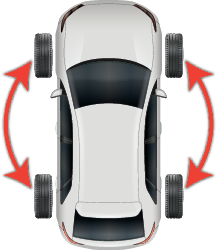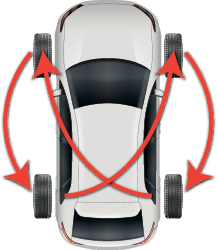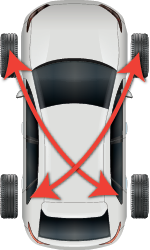You have already added that item to your appointment.

You have already added that item to your appointment.
If you’ve ever asked yourself, “How often should I rotate my tires,” you’re not alone. People ask us that all the time. To answer that question, let’s take a look at what a tire rotation is, why they’re important, how often to get yours done, and why you should choose Les Schwab for your next rotation.
Need to rotate your tires ASAP? Stop by any location or schedule an appointment.
A tire rotation is the act of changing the position of each tire on your car or truck every 5,000 miles or so. This simple bit of maintenance, which aligns with most oil changes (if you have a gas-powered vehicle), helps promote even tread wear on all four tires.
No matter how you drive, front and rear tires can wear down at different rates. By redistributing or rotating your tires, you can help avoid uneven wear caused by variations in driving conditions and axle placement. Additionally, tire rotations give the professionals at Les Schwab the chance to visually inspect your tires for damage, update the air pressure, rebalance if vibrations occur, and monitor tread depth. This can all add up to optimal tire performance, safety, and savings.
Timely tire rotations can help with a smoother ride, added safety, better fuel or range efficiency, and longer tire life. Regular rotations are important, even if you have an all-wheel drive vehicle. There really is no downside to periodic tire rotations, especially when they are usually free* when you buy your tires at Les Schwab.
Most automakers suggest rotating the tires every 5,000 miles or six months. However, this can vary based on where you drive, how you drive, what you drive, and the type of tires you have on that vehicle. If you’re not sure, stop by Les Schwab. We’ll take a look and make recommendations to help you get the most life out of your tires. After all, neglecting to rotate your tires can lead to irreversible wear patterns that can age your tires quickly.
Getting your tires rotated at Les Schwab can take about 30 minutes once your vehicle gets moved into our service bay. At Les Schwab, we’ll rotate your tires, balance them, check the air pressure, and give your vehicle’s safety systems a free visual inspection. If there are any concerns, we’ll explain them and show you all of your options.
The most common standard tire rotation is front-to-rear for tires with directional tread (designed to roll in one direction). Chances are, your vehicle requires this type of tire rotation. But there are multiple patterns that could also help promote long tire life. The rotation pattern that’s best for your car or truck is based on manufacturer recommendations as well as the type of tires you have. Please note: some rotations may include your spare if it is the same size, type, and pattern as your other four tires.

This type of rotation moves the rear tires to the front and the front tires to the rear. The side of the vehicle the tires are on is not changed. A front-to-rear rotation is used when the wear is normal and/or when the tires have directional tread (designed to roll in one direction).
Used when rear tires show uneven wear, the front tires are moved straight back to the rear. The rear tires move forward and switch sides of the vehicle.


If you drive a specific vehicle and are showing signs of uneven front tire wear, the rear tire and wheel assemblies are moved straight to the front while the front tires cross to the opposite rear positions.


Some vehicles have different size tire and wheel assemblies on the front when compared to the rear. In this case, Les Schwab swaps sides on the front as well as the rear.

This type of rotation moves the rear tires to the front and the front tires to the rear. The side of the vehicle the tires are on is not changed. A front-to-rear rotation is used when the wear is normal and/or when the tires have directional tread (designed to roll in one direction).

Used when rear tires show uneven wear, the front tires are moved straight back to the rear. The rear tires move forward and switch sides of the vehicle.

Used when there’s uneven tire wear found on most of the tires, this pattern moves the tires in an X pattern. The front and rear wheels are swapped front to back and left to right.

If you drive a specific vehicle and are showing signs of uneven front tire wear, the rear tire and wheel assemblies are moved straight to the front while the front tires cross to the opposite rear positions.

Some vehicles have different size tire and wheel assemblies on the front when compared to the rear. In this case, Les Schwab swaps sides on the front as well as the rear.
Les Schwab has been rotating tires for decades. When rotating and positioning your tires, Les Schwab looks carefully at manufacturer suggestions while also considering several critical factors. These include:
Whether your vehicle is front-wheel, rear-wheel, all-wheel, or four-wheel drive impacts the rotation pattern used to optimize tire wear and performance.
We’ll check for signs of uneven tire wear, which can indicate alignment or suspension issues that need to be addressed.
Directional tires, designed to rotate in one direction, require specific positioning to function correctly.
Or vehicles with staggered wheels or custom offset configurations, technicians adjust the rotation strategy to accommodate different wheel sizes or specific alignment setups.
If you have Les Schwab tires on your vehicle, rotations are free for the life of those tires in most cases. Plus, we’ll balance your wheels as part of the service. Don’t have Les Schwab tires? Our pros can still help maximize the life of your tires. Stop by your local Les Schwab for a quick estimate.
Don’t postpone your next tire rotation. Simple rotations can add life to your tires. When you buy your tires from us, we’ll rotate them for free on most vehicles. Plus, we provide free rotation reminders by email.
*Restriction apply. See store for details.